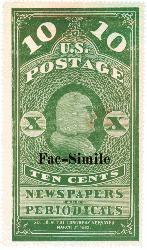The Facsimiles
Newspaper Stamps were illegal to own during the time they were in use. This resulted in many facsimiles and counterfeits. I use the term "Facsimile" to refer to reproductions that were not intentionally meant to deceive, and the term "counterfeit" for the items specifically altered or printed to be sold as originals. However I then named my Facsimile manual to cover the "small" newspaper stamps and the "Forgeries" to cover the large newspaper stamps.
Beginning in 1884, Gebruder Senf of Liebzig, Germany, begin producing facsimiles of stamps that were normally too difficult for collectors to obtain. The Senf brothers produced the best facsimiles. There were others. For the facsimiles, I have adopted and expanded the classification system developed by William Mooz and published in The American Philatelist, June 1984.
Some of the different types of facsimiles are as follows. More can be found in my reference work. I am interested in buying or trading. Send me an email to see what I have available.
There are 3
types of paper:
Type
I
paper is a very thin hard paper, 0.0025” thick, which matches the
thickness of the 1875 originals.
Type
II
paper is soft and 0.0035-0.0040 thick.
Type
III
paper is soft and 0.0030 thick which matchs the thickness of the 1879
originals. However the paper is very “yellow” and seems to be
of poor quality.
FA:
" FALSCH" is
present in the design (look at base of pedestal), but there is no
overprint. This
edition can easily deceive collectors. There was no 1¢ value of this
issue printed, but a
Senf advertisement stamp included in the set (image on right).
Wanted: Very much want a $1.92 to complete my set!
FBa: Overprinted "Facsimile" in upper and lower case letters in black 9 x 1m.
FBb: Overprinted
"Facsimile" in upper and lower case letters in blue
9 x 1m.
Wanted: All
but $24
FCa:
11 x 1 1/2 mm
"FACSIMILE" overprint in black with serifs.
.
FCb: 11 x 1 1/2 mm "FACSIMILE" overprint same as FCa but overprint in blue with serifs (Careful, the blue is very dark and hard to tell from black).
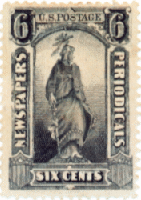
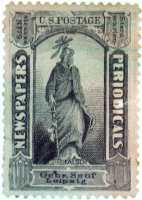

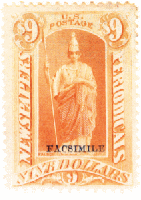
FDa:
15 x 1-1/2 mm
"FACSIMILE" overprint high on stamps.
Wanted: 1¢, 8¢, $24
FDb:
15 x 1 mm
"FACSIMILE" same as FDa, but overprint low on
stamps.
FE: 17 1/2 mm x 2 mm "FACSIMILE" overprint in purple hand stamp.
FF: 21x2 mm "FACSIMILIE" overprint in color of stamp.


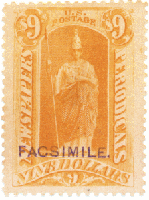
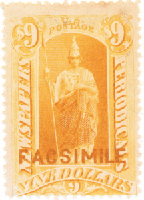
FG:
Overprinted
"Facsimile" in upper and lowercase letters in black, 14 x 2 mm, letters
without
serifs except for "a".
Wanted: 8¢, 10¢, 42¢
FH:
Overprinted
"FACSIMILE" in upper-case letters in black 19 x 1-1/2 mm.
Notice this is
not the same overprint as FBb.
Wanted: 1¢,
36-72¢, $1.92-$9, $24, $48, $60
FI: Circular cancellation reading "Lichtdruck Kuhl & Co".
FJ:
Circular cancellation
reading "Photographie". .
Wanted: 1¢,
6-10¢, 24-48¢, 846-10¢, $1.92-$3, $9-$60
FM: 14x2 mm "Phototypie" overprint.
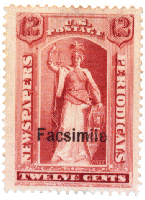

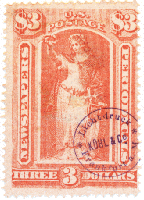
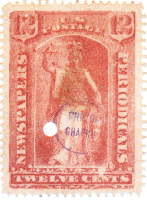

FN: Poorly printed on cheap paper with "FALSCH" and "FACSIMILE" worked into design. I am now of the opinion the dollar values of this set do not exist.
FO: Poorly printed with "Faux" worked into the design and "Facsimile" overprint 10 x 3/4 mm (very hard to see). My blacks are overprinted in red, my higher values overprinted in black. William Mooz does not mention an overprint on his blacks at all. Is there a set out there with no overprints and a set with overprints? Contact me if you have information.
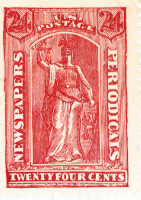
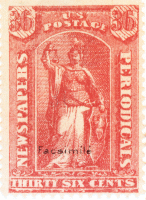
PR26 Block Mystery
This
item doesn’t really make sense. I don’t know if it’s “new” or an “old” piece,
but it’s a bit of a mystery. Let’s take
some theories.
Theory
#1- Unfinished FM Facsimiles: Obviously photography, the sheet comes
closest to a FM. Perhaps it’s a sheet of
FMs before they were perforated, split apart and overprinted “Phototypie”? There are troubles with this theory. First, where did someone get a partial sheet
of PR26s (in the 1880’s) from to take this picture? The stamps themselves are all different
leading one to believe this isn’t a “cut and paste” job using a single
photo. But let’s say they did find a
partial imperforated sheet (maybe a partial sheet of card proofs?) My second big problem is that the camera
must have been a really lousy one. The
quality of the images is very much poorer then my FMs. They are similar to my FMs, but do not
“match” my FMs. You are also going
through “unnecessary work”. Why
photograph the sheet inscription if you’re then simply going to break the sheet
apart to create sets of FMs?
Theory
#2- Modern Forgery
This
was possibly created by a modern forger.
A block of 8 would be very desirable.
The trouble with this theory is that, again, the camera work is very
lousy. My iPhone can produce a very much
better image. This sheet would not fool anyone today and a block of 8 would
certainly be “noticed” by the newspaper stamp community and carefully
inspected. The paper does not look
modern either. It has a manila colored
hue and is vertically “ribbed” (unlike any other facsimile I’ve seen).
Theory
#3- Old Forgery
This
is the best theory of the three right now.
The old forgers were able to dupe the average collector since they
seldom had originals to compare to. If
you did not have an original PR26, you would not realize the poor quality of
these PR26s.

Reference works available:
United States Newspaper Stamps: 1875-1885- The Facsimiles
This work is a study of the small newspaper stamp facsimiles. With 100 illustrations, it types and illustrates all the small newspaper stamp facsimiles and the forgers who produced them. Invaluable reference work (See the Home Page).
United States Newspaper Stamps: 1865-1869- The Forgeries
With over
100 illustrations, it types all the large
newspaper stamp forgeries and explains how to tell them apart from each
other and from the
regular issues. This is invaluable for the dealer or collector trying
to identify the real
ones, and for the specialist trying to organize material.
(See the Home Page.)
In my own album I have grouped the "counterfeits" and "facsimiles" under the general heading of "forgeries." It is obvious that the same forger in some instances made it clear his items were forgeries (by, as an example, adding a facsimile overprint), while at the same time created items with no overprint that appear to be to truly deceive. A Type II and Type VI forgery are illustrated below.
